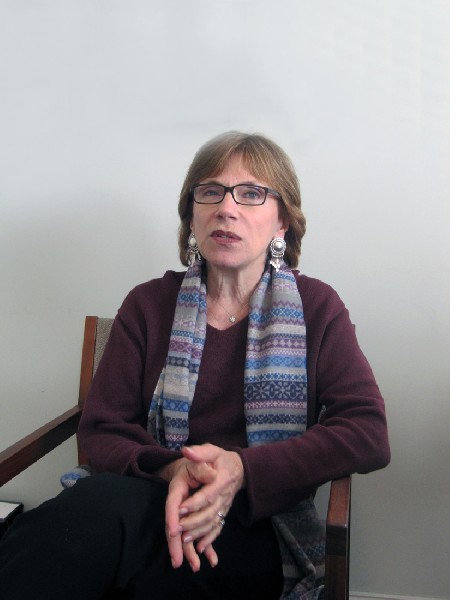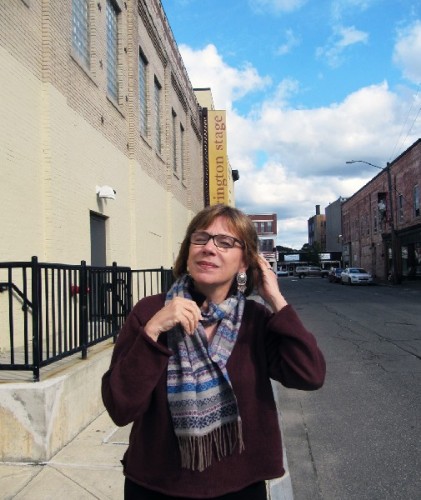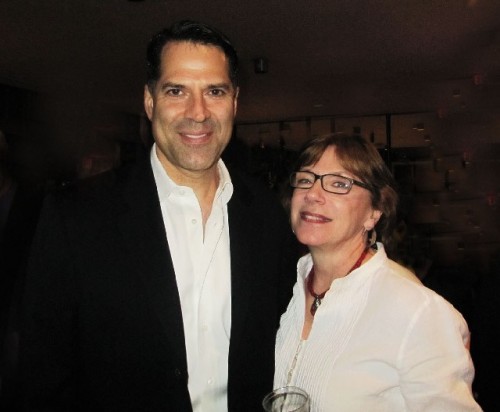Julianne Boyd of Barrington Stage Company
Producing Plays That Matter
By: Julianne Boyd and Charles Giuliano - Oct 10, 2011
Charles Giuliano Last summer in high season you introduced a tough new drama on the Main Stage The Best of Enemies by Mark St. Germain. What kind of risk was involved?
Julianne Boyd It was a big risk. I try to think through my risks and take cautious risks. If there is such a thing. When Mark and I talked he really preferred for it to be on Stage Two.
CG He said you talked him out of it.
JB That’s right. We realized very early that we wanted to use the Gospel choir.
CG Which you are not doing now.
JB No. Where was I going to put 28 people waiting to come on stage. We thought it would be a great community event and kind of wonderful. During a live reading we did there was a Gospel tune and we said, hey, why not get a live choir? But that wasn’t going to be possible on Stage Two which doesn’t have any backstage area.
Then I thought these characters are larger than life. They can inhabit a larger stage.
Mark already had a following here with Freud’s Last Session. It was not like a new play by an unknown author.
Just before the season was chosen we went back and forth between Main Stage and Stage Two.
CG During our interview I asked Mark about the extent to which Freud’s Last Session was a game changer for his career. He down played that.
JB I wasn’t sure that people who liked Freud would like Best of Enemies. We were dealing with really strong subject matter and language. We weren’t sure how people would take it. Because it’s honest language and the way people talked. Even in rehearsal John Bedford Lloyd said “Will people be throwing tomatoes at me after that opening speech?”
I said, no they won’t, because you’re going to capture them. Those opening speeches capture the attention of the audience. Then they go on a journey with you and the fact that you are transformed through the hour and a half of the play. Audiences love transformational stories of people who change. The audience will be with you.
CG He had concerns.
JB Initially. We talked about it the first few days of rehearsal. I don’ think any of us had seen that kind of language in a play. The racial epithets. Maybe in a movie but not when you’re standing really close to somebody. We were all so committed to the play and the story. We would do whatever it took to get it on the stage. John’s commitment to the play was so total that he said let’s just go with it. It’s a great role and he loved it. A man that changes so much. He and Aisha (Hinds as Ann Atwater) just got along wonderfully. In the first rehearsals he apologized to her for using some of those names. Now it has become not commonplace but we look at it as a part of our work. Those lines soon became a part of our job. That’s what you have to do to affect people.
CG I asked Mark if there were shock value in those words and that material.
JB It was not at all shock value. If you read the book that’s the language of that time and the language that people are still speaking. Mark is not a shock value writer. As Northerners who did not live through that period in the South so that language is perhaps more shocking.
CG Inadvertently that has become a theme of this theatre season. You and I attended opening night of Porgy and Bess at ART. While in Boston we also saw the musical Big River based on The Adventures of Huckleberry Finn at Lyric Stage. Mark Twain used the n-word more than 200 times in that novel and it also appears, less frequently, in the musical adaptation. Race and the language of bigotry have been a prominent issue in theatre this season. There was the controversy of the Sondheim letter to the Times in which he objected to what he anticipated as attempts to change a classic in an adaptation more palatable to a contemporary audience.
JB Is it that we are finally coming to terms with it? For awhile we shied away from it.
CG How are we coming to terms with it?
JB By showing something like Best of Enemies. That hatred and what happens to people who have that strong hatred. There is that wonderful speech by Bill Riddick (The Department of Education field worker) when he reels off all of the possible racial slurs for blacks and whites. At the end of it he asks “Are there any more?” Ann Atwater says “There are always more.”
CG That’s one of the riveting moments in the play. How did you deal with it as a director?
JB We talked about are there any names we are leaving out. The cast came up with names that are missing. Then we talked about names for other racial groups. Like Italians. I’m Italian.
CG You don’t look Italian. Where did you get those blues eyes?
JB 100%. My dad is Sicilian and my mother is from Abruzzi. My maiden name is Mamana.
We talked about racial epithets and realized that there are a lot of them. We googled them and then started to laugh as we hadn’t heard a lot of them. It’s very difficult to memorize that speech because there’s no reason why one epithet comes after another.
CG It’s like the Lucky speech in Waiting for Godot.
JB Yes. (starts to recite the Lucky speech)
CG Come on how do you know that speech?
JB I played Lucky in college.
CG Wow. How hard was it to memorize that speech?
JB Very easy when you’re nineteen or twenty. That speech and that scene brought us closer together. It’s so effective.
CG In dealing with this work what did you learn about society and yourself in regard to bigotry?
JB I’ve always been a very liberal person. What I learned is the value of listening to others. Not just hearing what they say but listening. What brought Ann and C. P. together was their ability to listen to one another; to dig deeper than the racial epithets. What they learned is that in their world it wasn’t about color. It was about class and poverty. When they started talking they found that they both wanted the same things for their children. C. P. thought his kids were treated like white trash. Ann thought her children were treated beyond trash and nobody every listened.
In Durham there is the tobacco industry which the whites run. C. P. was just the gopher of the rich owners. They were bigoted to a large extent. The Ku Klux Klan served white power. But also in Durham, as Ann realized, is Mutual Life Insurance Company, the largest black owned insurance company in America. There was a big difference between where Ann was and the upper middle class blacks. They both realized that they were being used. That the richer people were not helping the poorer people. They had to help themselves.
CG There is an interesting dynamic when we have an enemy or a battle with another race, religion, neighbor, lover, friend. When you exchange hateful shots at each other and they come back with equal ferocity. At some point in the back and forth there is the realization that you have given it your best shot and the other person or group is still standing. There is a tipping point where hate evolves to respect, commonality, and love. (Love thy enemy as thy self.)
JB There is a recognition moment first. With C. P. it was “people think of me as a white nigger and say that I’m no better than you.” Then he says to himself “What did I just say?” He suddenly realizes that was an insensitive and incorrect thing to say to Ann.
CG Ann isn’t easy on him.
JB No. She hated him. Ann Atwater said that she hated all white people before she developed a friendship with C. P.
CG Let’s talk about Porgy and Bess in relation to what you are doing here.
JB I just love Porgy and Bess.
CG There was a preamble to the production with the Sondheim letter to the Times. Or the arguments about a sanitized edition of Huck Finn.
JB I don’t think they’re sanitizing Porgy and Bess. Do you?
CG That was the dialogue that preceded the production.
JB I don’t know the show well enough before. I think they were looking for more depth in the characters. I don’t know it well enough. People are talking a lot but I don’t know if they know the difference or how much difference there is. What I have read is that Diane (Paulus) and her team are trying to make it an exciting work in the musical theatre. To take it from an opera, which puts a barrier up for some people, and to make it more accessible. They were trying to make it into a work which was more for the populus. I thought it was an exciting production.
CG So for you it worked. Mostly you went to see Christopher Innvar (The Sheriff).
JB We’re friends and have worked together since 2003. We feel similarly about plays.
CG Would you have gone to see it otherwise?
JB I would have waited for NY. I don’t think I would have gone to Boston to see it. When Chris invited me I thought this is great. I also love Audra’s (Macdonald as Bess) work and Norm Lewis’s work (Porgy). It’s a very talented cast. Nikki Renee Daniels (Clara) had worked here with Bill Finn so I knew several people in the cast which was exciting. This was serious musical theatre which I love Charles. I saw the Houston Grand Opera version (1976). It was a glorious production. Maybe before I went I should have taken the time to listen to the original but I didn’t have the time. Did you do that?
CG Actually we heard the concert version at Tanglewood the week before seeing it at ART. With the exception of Audra Macdonald the Tanglewood singers were superior. Jermaine Smith as Sporting Life was just incredible. In addition to great singing he had wonderful slithery moves including leaping into the air and doing splits. David Alan Grier at ART who played him was an actor and not really a singer. What we heard at Tanglewood in a concert version featured the best possible voices. The ART production was effective dramatically but less so musically. The ART Clara singing “Summertime” paled by comparison to Nicole Cabell at Tanglewood. Then when Audra Macdonald also sang “Summertime” later in the show it was just riveting.
Compared to other art forms we don’t repaint the canvases of Rembrandt. But in theatre plays are always being reworked. There are certain expectations in the ways that we look at classical works of theatre like Porgy and Bess or a new edit of Huck Finn as the musical Big River.
JB That was an adaptation of the book. There is a difference in adapting a book to make it a musical, than adapting a musical that’s already written and adapting it into another musical. When the authors are dead. That’s a challenge. It’s very difficult. The creative team of Porgy and Bess had the permission of the Gershwin estate. Would I do it? I’m less inclined. I’m interested in reinterpreting a work which already exists. But I’m not inclined to change that work. My challenge as a director is to see if I can give life to a work. It’s exciting to say how can I give life to West Side Story or Sweeney Todd? Sweeney Todd exists so I didn’t want to do the John Doyle version.
Sometimes I want to cut a stanza or a verse. I might not have great dancers. I might want to cut a number because I don’t have the right people to sing it. I’ve made small changes but I’ve never wanted to reinvent a work to the extent of making it totally new. I have a very special place in my heart for playwrights. I work them all the time through our Musical Theatre Lab. I’m trying to hear the writer’s voice. I don’t want to change the writer’s voice I’m just trying to hear it.
CG Barrington seems to have achieved a mix between established works particularly popular musicals and new material. Other theatres offer new works but you have a gift for finding plays that are tough, insightful and gritty.
JB I’m attracted to exactly what you are saying. I’m attracted to gritty plays with strong emotional centers. I’ve come to realize in the past couple of years that I’m attracted to plays with social issues. I’m not attracted to plays about dysfunctional families. It doesn’t interest me. Everyone does them. You turn on television. You look at the movies.
CG But what about Mormons, Mothers and Monsters? (A new musical this past summer that opened to mixed/ negative reviews.)
JB That was something different. It was about Mormonism. How you have to be a part of a very tight religion to live. It’s about this young man breaking out who also realized that he was gay.
I mean these lovely little light dramas. Like after a divorce can you believe mom’s dating? I don’t care.
CG You describe a phenomenon about twenty something and thirty something playwrights. They have been told that they are beautiful and talented. Their every utterance is regarded as a manifestation of genius. They have paid $100,000 to be nurtured through elite MFA programs. The professors have encouraged them to express themselves and write about themselves and what they know.
JB That’s so interesting I was just thinking about that today. Let’s look at Porgy and Bess. When Dubois Heywood wrote Porgy nobody was saying to him “Write about yourself.” He knew these people, the Gullah people of the Carolinas. They were not his people but based on what he saw he wrote about people he recognized. Stories that needed to be told. I’m much more interested in people writing stories, whether they are about themselves or not, that deal with deep issues. With Asher Lev I’m not Jewish but I so identified with Asher Lev as an artist who had to go against the grain.
My father wanted me to be a teacher. Did he want me to be a theatre director? No. I grew up in the 1960s. So, if your husband dies, as a teacher you can be at home with your children in the summer. What? It was about having security for the future.
Asher Lev and The Whipping Man are stories about people who I want to get to know. And what they’ve gone through. Best of Enemies. They’re universal stories. There are universal coming of age stories. I don’t mean there can’t be dysfunctional coming of age stories. Just in general, and our audiences are really liking them. When people come to the theatre they want to get out of their own world. They don’t want to see on the stage their children, their aunts and uncles, or parents. Most of the time. Some of the time I just want to laugh. I can’t say that every single play we do is for social significance. Guys and Dolls was fun. We just wanted to have fun.
Part Two




